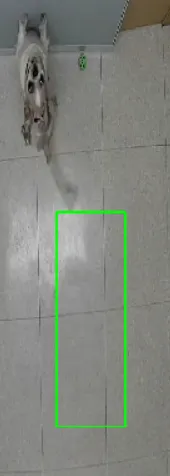我一直在尝试制作一个运动跟踪器,以追踪录制在顶部的视频中移动的狗,并检索出显示狗的裁剪视频并忽略其余背景的内容。
我首先尝试使用opencv 3中可用的算法(BOOSTING、MIL、KCF、TLD、MEDIANFLOW、GOTURN(返回错误,尚未解决))进行对象跟踪,从此链接中获取。我甚至尝试了通过减去第一帧来进行基本的运动跟踪算法,但是它们都没有给出良好的结果。链接 我希望代码有一个预设的矩形框,一旦检测到运动,就会围绕运动区域。就像这个视频中的那样。
我对OPENCV不是很熟悉,但我相信单一运动跟踪不应该是一个问题,因为已经有很多相关工作已经完成。我是否应该考虑其他库/API,或者是否有更好的代码/教程可以让我完成这个任务?我的目的是将其与神经网络一起使用(这就是为什么我试图使用python/opencv解决它的原因)。
感谢任何帮助/建议。
编辑:
我删除了之前的代码,以使帖子更加清洁。
此外,根据我得到的反馈和进一步的研究,我能够修改一些代码,使其接近我想要的结果。然而,我仍然有一个烦人的跟踪问题。似乎第一帧影响了后面的跟踪,因为即使狗移动了,它仍然保持检测到的第一个位置。我尝试使用标志来限制只跟踪1个动作,但检测会出现问题。这是代码和显示结果的图片:
这张图片展示了第一帧仍然影响着帧差结果,这迫使包围框覆盖了没有运动的区域。 这个案例展示了当忽略运动并错误地检测到不存在的运动(视频第二帧和第一帧之间的帧差)时的情况。当我允许多重跟踪时,它会同时跟踪两者,但仍然是错误的,因为它检测到了一个空的区域。
我首先尝试使用opencv 3中可用的算法(BOOSTING、MIL、KCF、TLD、MEDIANFLOW、GOTURN(返回错误,尚未解决))进行对象跟踪,从此链接中获取。我甚至尝试了通过减去第一帧来进行基本的运动跟踪算法,但是它们都没有给出良好的结果。链接 我希望代码有一个预设的矩形框,一旦检测到运动,就会围绕运动区域。就像这个视频中的那样。
我对OPENCV不是很熟悉,但我相信单一运动跟踪不应该是一个问题,因为已经有很多相关工作已经完成。我是否应该考虑其他库/API,或者是否有更好的代码/教程可以让我完成这个任务?我的目的是将其与神经网络一起使用(这就是为什么我试图使用python/opencv解决它的原因)。
感谢任何帮助/建议。
编辑:
我删除了之前的代码,以使帖子更加清洁。
此外,根据我得到的反馈和进一步的研究,我能够修改一些代码,使其接近我想要的结果。然而,我仍然有一个烦人的跟踪问题。似乎第一帧影响了后面的跟踪,因为即使狗移动了,它仍然保持检测到的第一个位置。我尝试使用标志来限制只跟踪1个动作,但检测会出现问题。这是代码和显示结果的图片:
jimport imutils
import time
import cv2
previousFrame = None
def searchForMovement(cnts, frame, min_area):
text = "Undetected"
flag = 0
for c in cnts:
# if the contour is too small, ignore it
if cv2.contourArea(c) < min_area:
continue
#Use the flag to prevent the detection of other motions in the video
if flag == 0:
(x, y, w, h) = cv2.boundingRect(c)
#print("x y w h")
#print(x,y,w,h)
cv2.rectangle(frame, (x, y), (x+w, y+h), (0, 255, 0), 2)
text = "Detected"
flag = 1
return frame, text
def trackMotion(ret,frame, gaussian_kernel, sensitivity_value, min_area):
if ret:
# Convert to grayscale and blur it for better frame difference
gray = cv2.cvtColor(frame, cv2.COLOR_BGR2GRAY)
gray = cv2.GaussianBlur(gray, (gaussian_kernel, gaussian_kernel), 0)
global previousFrame
if previousFrame is None:
previousFrame = gray
return frame, "Uninitialized", frame, frame
frameDiff = cv2.absdiff(previousFrame, gray)
thresh = cv2.threshold(frameDiff, sensitivity_value, 255, cv2.THRESH_BINARY)[1]
thresh = cv2.dilate(thresh, None, iterations=2)
_, cnts, _ = cv2.findContours(thresh.copy(), cv2.RETR_EXTERNAL, cv2.CHAIN_APPROX_SIMPLE)
frame, text = searchForMovement(cnts, frame, min_area)
#previousFrame = gray
return frame, text, thresh, frameDiff
if __name__ == '__main__':
video = "Track.avi"
video0 = "Track.mp4"
video1= "Ntest1.avi"
video2= "Ntest2.avi"
camera = cv2.VideoCapture(video1)
time.sleep(0.25)
min_area = 5000 #int(sys.argv[1])
cv2.namedWindow("Security Camera Feed")
while camera.isOpened():
gaussian_kernel = 27
sensitivity_value = 5
min_area = 2500
ret, frame = camera.read()
#Check if the next camera read is not null
if ret:
frame, text, thresh, frameDiff = trackMotion(ret,frame, gaussian_kernel, sensitivity_value, min_area)
else:
print("Video Finished")
break
cv2.namedWindow('Thresh',cv2.WINDOW_NORMAL)
cv2.namedWindow('Frame Difference',cv2.WINDOW_NORMAL)
cv2.namedWindow('Security Camera Feed',cv2.WINDOW_NORMAL)
cv2.resizeWindow('Thresh', 800,600)
cv2.resizeWindow('Frame Difference', 800,600)
cv2.resizeWindow('Security Camera Feed', 800,600)
# uncomment to see the tresh and framedifference displays
cv2.imshow("Thresh", thresh)
cv2.imshow("Frame Difference", frameDiff)
cv2.putText(frame, text, (10, 20), cv2.FONT_HERSHEY_SIMPLEX, 0.5, (0, 0, 255), 2)
cv2.imshow("Security Camera Feed", frame)
key = cv2.waitKey(3) & 0xFF
if key == 27 or key == ord('q'):
print("Bye")
break
camera.release()
cv2.destroyAllWindows()
这张图片展示了第一帧仍然影响着帧差结果,这迫使包围框覆盖了没有运动的区域。 这个案例展示了当忽略运动并错误地检测到不存在的运动(视频第二帧和第一帧之间的帧差)时的情况。当我允许多重跟踪时,它会同时跟踪两者,但仍然是错误的,因为它检测到了一个空的区域。
有人知道代码哪里出错或者缺少了什么吗?我一直在尝试但是无法使其正常工作。
提前感谢!!

